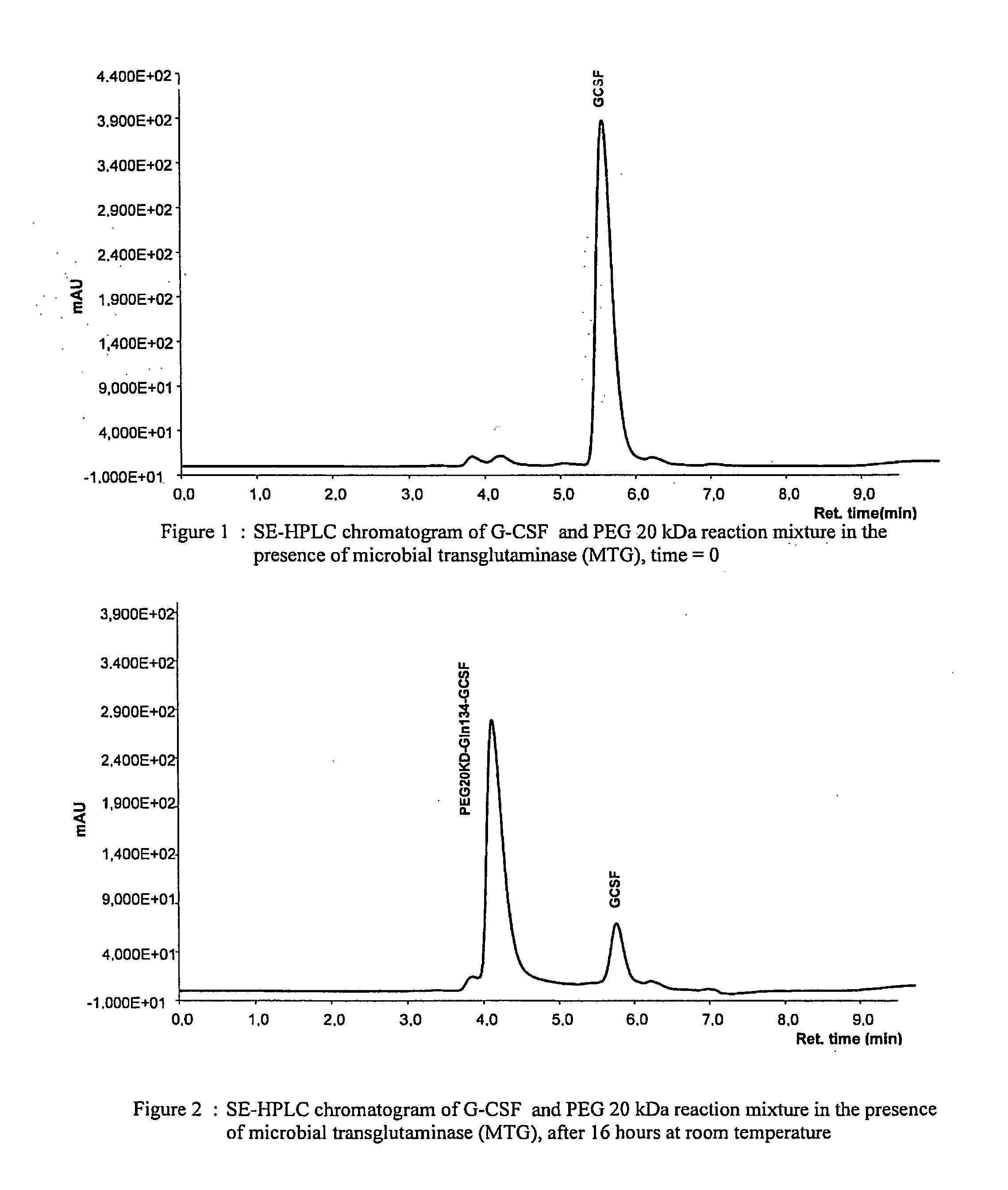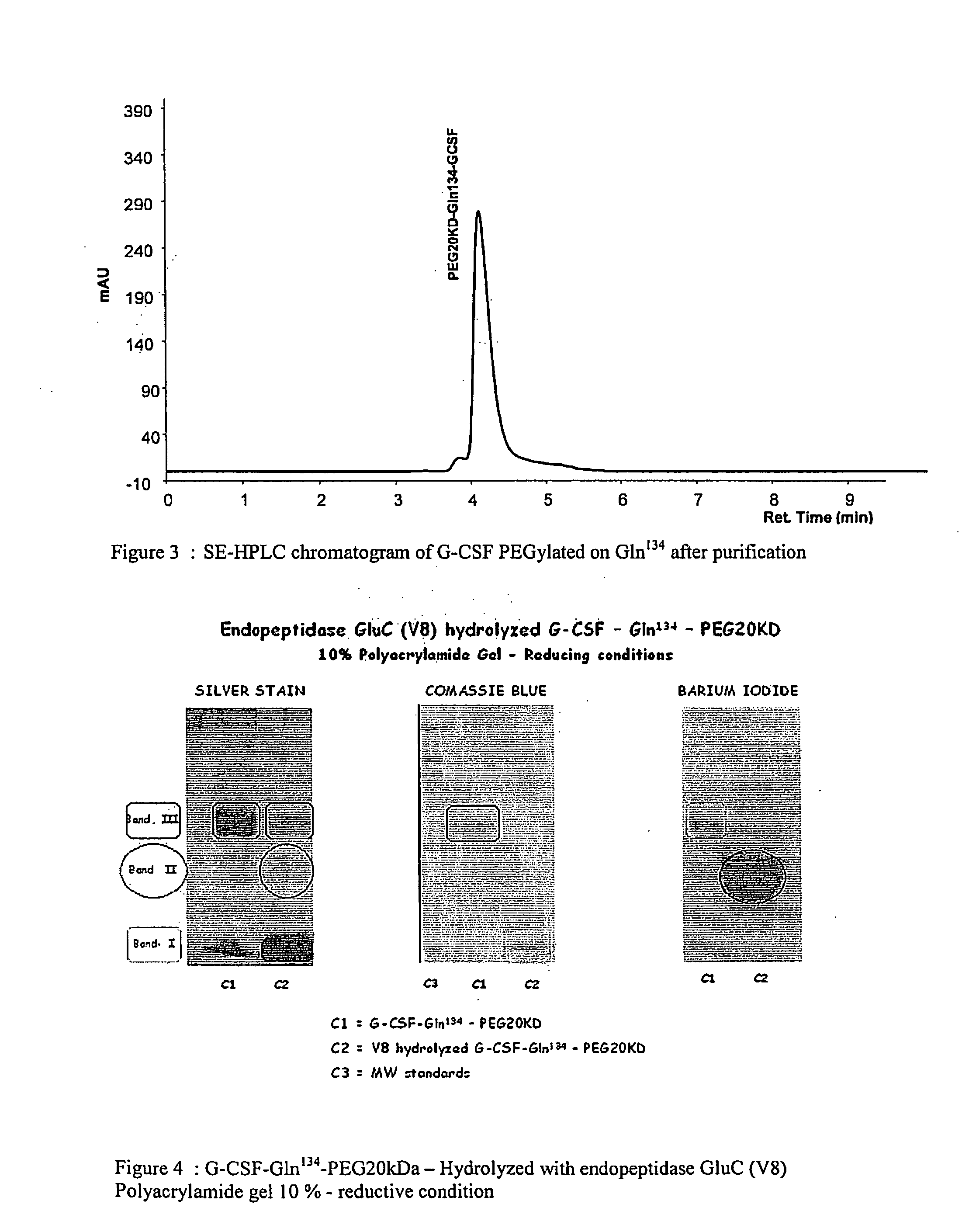G-csf site-specific mono-conjugates
- Summary
- Abstract
- Description
- Claims
- Application Information
AI Technical Summary
Problems solved by technology
Method used
Image
Examples
example 1
Preparation of the Site-Specific Mono-PEGylated G-CSF-Gln134-PEG20 kDa Derivative
[0106]Nonglycosilated rec-G-CSF, expressed in E. coli, was dissolved in 10 mM potassium dihydrogen phosphate buffer at pH 7.4 to a concentration of 1 mg / ml of protein, corresponding to about 53 μM. 20 kDa monomethoxy-poly(ethylene glycol) amine(methoxypoly(ethylene glycol) amine 20000, Fluka) was then added to the protein solution to a molar ratio of 10:1 PEG:G-CSF. After adding microbial transglutaminase (Activa WM, Ajinomoto) at a concentration of 0.024 U / ml reaction solution, the protein solution was incubated for 16 hours at room temperature under gentle agitation. After completing the reaction, the solution was diluted using 20 mM sodium acetate buffer at pH 4.0 and purified by column chromatography (CM Sepharose), eluting with a linear gradient (from 0 to 500 mM NaCl in 15 column volumes). A pool of the fractions containing monoPEGylated G-CSF was concentrated and subjected to gel filtration on a ...
example 2
Determination of rec-h-G-CSF-Gln134-PEG20 kDa Conjugation Site
[0108]A purified rec-h-G-CSF-Gln134-PEG20 kDa compound was hydrolysed enzymatically using endoproteinase GluC. It was incubated at pH 8.8 for 18 hours at a temperature of 37° C. in 120 mM NH4HCO3 buffer.
[0109]After digestion, the peptide mixture was analysed by polyacrylamide gel electrophoresis, which separated three electrophoretic bands (see FIG. 4): (I) migration corresponding to proteins with a molecular weight lower than 4,000 Da; (II) migration corresponding to proteins with a molecular weight of about 40,000 Da; (III) migration corresponding to proteins with a molecular weight of about 60,000 Da. The latter is the non-hydrolysed PEGylated protein residue, having a calculated molecular weight of 38,798 Da (20,000+18,798). Its migration to a higher molecular weight must be ascribed to the encumbrance of PEG20 kDa, which corresponds to a double size globular protein (40 kDa). Band II displays a strong positive reacti...
example 3
Gln159Asn and Gln159Asn / Gln135Asn met-G-CSF Mutants PEGylation to PEG20 kDa-NH2 by Microbial TG-ase
[0112]Each nonglycosylated mutant, expressed in E. coli, was dissolved in 10 mM potassium dihydrogen phosphate solution at pH 7.4 and at a concentration of 1 mg protein / ml, corresponding to about 53 μM. 20 kDa monomethoxy-poly(ethylene glycol) amine(methoxypoly(ethylene glycol) amine 20000, Fluka) was then added to the protein solution to a molar ratio of 10:1 PEG:G-CSF. After adding microbial transglutaminase (Activa WM, Ajinomoto) at a concentration of 0.024 U / ml reaction solution, the protein solution was incubated for 16 hours at room temperature under gentle agitation. An aliquot of the reaction mixture was analysed on a SE-HPLC column at the beginning and the end of the reaction to determine the yield and protein concentration.
[0113]The fact that the double mutant Gln159Asn / Gln135Asn did not yield any PEGylated products, as opposed to the single mutant Gln159Asn, signifies that c...
PUM
| Property | Measurement | Unit |
|---|---|---|
| molecular weight | aaaaa | aaaaa |
| molecular weight | aaaaa | aaaaa |
| molecular weight | aaaaa | aaaaa |
Abstract
Description
Claims
Application Information
 Login to View More
Login to View More - R&D
- Intellectual Property
- Life Sciences
- Materials
- Tech Scout
- Unparalleled Data Quality
- Higher Quality Content
- 60% Fewer Hallucinations
Browse by: Latest US Patents, China's latest patents, Technical Efficacy Thesaurus, Application Domain, Technology Topic, Popular Technical Reports.
© 2025 PatSnap. All rights reserved.Legal|Privacy policy|Modern Slavery Act Transparency Statement|Sitemap|About US| Contact US: help@patsnap.com



